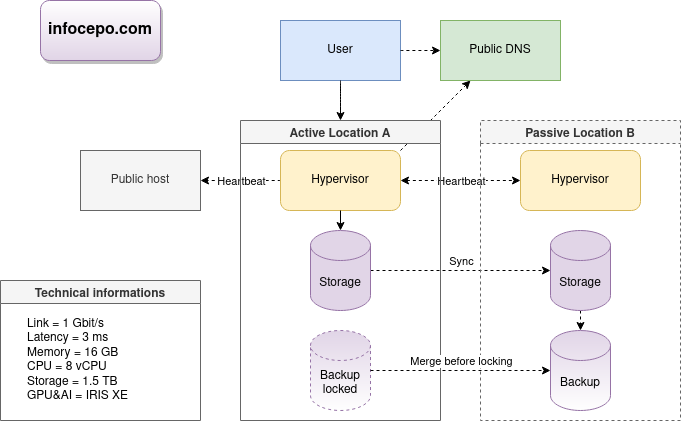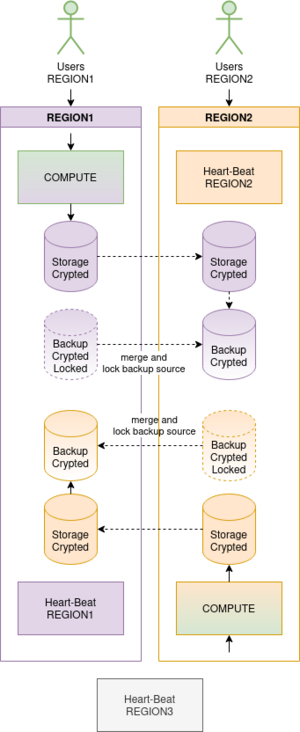Main Page: Difference between revisions
Jump to navigation
Jump to search
| Line 92: | Line 92: | ||
! oVirt | ! oVirt | ||
|- | |- | ||
| | | '''Deployment Tools'''<br>''(Tools used for deployment)'' | ||
| Helm, YAML, Operator, Ansible, Juju | | Helm, YAML, Operator, Ansible, Juju | ||
| Ansible, Packer, Terraform, Juju | | Ansible, Packer, Terraform, Juju | ||
| Line 101: | Line 101: | ||
| Ansible, Python, Shell Scripts | | Ansible, Python, Shell Scripts | ||
|- | |- | ||
| | | '''Bootstrap Method'''<br>''(Initial configuration and setup)'' | ||
| API | | API | ||
| API, PXE | | API, PXE | ||
| Line 110: | Line 110: | ||
| PXE, API | | PXE, API | ||
|- | |- | ||
| | | '''Router Control'''<br>''(Routing services)'' | ||
| API (Kube-router) | | API (Kube-router) | ||
| API (Router/Subnet) | | API (Router/Subnet) | ||
| Line 119: | Line 119: | ||
| API | | API | ||
|- | |- | ||
| | | '''Firewall Control'''<br>''(Firewall rules and policies)'' | ||
| Ingress, Egress, Istio, NetworkPolicy | | Ingress, Egress, Istio, NetworkPolicy | ||
| API (Security Groups) | | API (Security Groups) | ||
| Line 128: | Line 128: | ||
| API | | API | ||
|- | |- | ||
| | | '''Network Virtualization'''<br>''(VLAN/VxLAN technologies)'' | ||
| Multiple Options | | Multiple Options | ||
| VPC | | VPC | ||
| Line 137: | Line 137: | ||
| API | | API | ||
|- | |- | ||
| | | '''Name Server Control'''<br>''(DNS services)'' | ||
| CoreDNS | | CoreDNS | ||
| DNS-Nameserver | | DNS-Nameserver | ||
| Line 146: | Line 146: | ||
| API, External Hardware | | API, External Hardware | ||
|- | |- | ||
| | | '''Load Balancer'''<br>''(Load balancing options)'' | ||
| Kube-proxy, LVS (IPVS) | | Kube-proxy, LVS (IPVS) | ||
| LVS | | LVS | ||
| Line 155: | Line 155: | ||
| N/A | | N/A | ||
|- | |- | ||
| | | '''Storage Options'''<br>''(Available storage technologies)'' | ||
| Multiple Options | | Multiple Options | ||
| Swift, Cinder, Nova | | Swift, Cinder, Nova | ||
Revision as of 20:01, 12 September 2023
Welcome to my WIKI.
It explores cloud computing, focusing on migration, infrastructure, and high availability. It discusses tools like Kubernetes, OpenStack, AWS, emphasizes open-source software, and outlines key factors for cloud infrastructure implementation.
CLOUD LAB

Presenting my LAB project.
CLOUD Audit
Created ServerDiff.sh for server audits. Enables configuration drift tracking and environment consistency checks.
CLOUD Migration Example
- 1.5d: Infrastructure audit of 82 services (ServerDiff.sh)
- 1.5d: Create cloud architecture diagram
- 1.5d: Compliance check of 2 clouds (6 hypervisors, 6TB memory)
- 1d: Cloud installations
- .5d: Stability check
| ACTION | RESULT | OK/KO |
| Activate maintenance for n/2-1 nodes or 1 node if 2 nodes. | All resources are started. | |
| Un-maintenance all nodes. Power off n/2-1 nodes or 1 node if 2 nodes, different from the previous test. | All resources are started. | |
| Power off simultaneous all nodes. Power on simultaneous all nodes. | All resources are started. |
- 1.5d: Cloud automation study
- 1.5d: Develop 6 templates (2 clouds, 2 OS, 8 environments, 2 versions)
- 1d: Create migration diagram
- 1.5d: Write 138 lines of migration code (MigrationApp.sh)
- 1.5d: Process stabilization
- 1.5d: Cloud vs old infrastructure benchmark
- .5d: Unavailability time calibration per migration unit
- 5min: Load 82 VMs (env, os, application_code, 2 IP)
Total = 15 man-days
CLOUD Enhancement
- Formalize infrastructure for flexibility and reduced complexity.
- Utilize customer-location tracking name server like GDNS.
- Use minimal instances with a network load balancer like LVS.
- Compare prices of dynamic computing services, beware of tech lock-in.
- Employ efficient frontend TLS decoder like HAPROXY.
- Opt for fast HTTP cache like VARNISH and Apache Traffic Server for large files.
- Use REVERSE PROXY with TLS decoder like ENVOY for service compatibility.
- Consider serverless service for standard runtimes, mindful of potential incompatibilities.
- Employ load balancing or native services for dynamic computing power.
- Use open source STACKs where possible.
- Employ database caches like MEMCACHED.
- More information at CLOUD WIKIPEDIA.
CLOUD WIKIPEDIA
CLOUD vs HW
| Function | Kubernetes | OpenStack | AWS | Bare-metal | HPC | CRM | oVirt |
|---|---|---|---|---|---|---|---|
| Deployment Tools (Tools used for deployment) |
Helm, YAML, Operator, Ansible, Juju | Ansible, Packer, Terraform, Juju | Ansible, Terraform, CloudFormation, Juju | Ansible, Shell Scripts | xCAT, Clush | Ansible, Shell Scripts | Ansible, Python, Shell Scripts |
| Bootstrap Method (Initial configuration and setup) |
API | API, PXE | API | PXE, IPMI | PXE, IPMI | PXE, IPMI | PXE, API |
| Router Control (Routing services) |
API (Kube-router) | API (Router/Subnet) | API (Route Table/Subnet) | Linux, OVS, External Hardware | xCAT, External Hardware | Linux, External Hardware | API |
| Firewall Control (Firewall rules and policies) |
Ingress, Egress, Istio, NetworkPolicy | API (Security Groups) | API (Security Group) | Linux Firewall | Linux Firewall | Linux Firewall | API |
| Network Virtualization (VLAN/VxLAN technologies) |
Multiple Options | VPC | VPC | OVS, Linux, External Hardware | xCAT, External Hardware | Linux, External Hardware | API |
| Name Server Control (DNS services) |
CoreDNS | DNS-Nameserver | Amazon Route 53 | GDNS | xCAT | Linux, External Hardware | API, External Hardware |
| Load Balancer (Load balancing options) |
Kube-proxy, LVS (IPVS) | LVS | Network Load Balancer | LVS | SLURM | Ldirectord | N/A |
| Storage Options (Available storage technologies) |
Multiple Options | Swift, Cinder, Nova | S3, EFS, FSx, EBS | Swift, XFS, EXT4, RAID10 | GPFS | SAN | NFS, SAN |
CLOUD providers
CLOUD INTERNET NETWORK
CLOUD NATIVE
High Availability (HA) with Corosync+Pacemaker
Typical Architecture
- Dual-room.
- IPMI LAN (fencing).
- NTP, DNS+DHCP+PXE+TFTP+HTTP (auto-provisioning), PROXY (updates or internal REPOSITORY).
- Choose 2+ node clusters.
- For 2-node, require COROSYNC 2-node config, 10-second staggered closing for stability.
- Stateless resources. Allocate 4GB/base for DB resources. CPU resource requirements generally low.
Typical Service Pattern
- Multipath
- LUN
- LVM (LVM resource)
- FS (FS resource)
- NFS (FS resource)
- User
- IP (IP resource)
- DNS name
- Process (Process resource)
- Listener (Listener resource)
AI Solutions
- CHATGPT - Essential AI wizard. For better productivity, you have to pay (28/06/2023)
- MIDJOURNEY - design
DEV
- RANKING - AI models compare.
- LANGCHAIN - Semantic tool.
NEWS
- CLAUDE is now better than CHATGPT on the interpretation of long texts.




